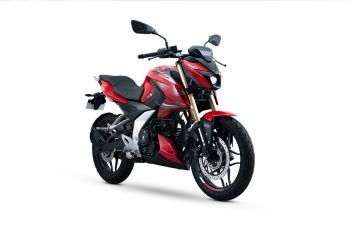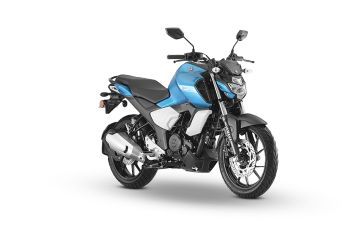Explore all New Cars of 2025
Bajaj Pulsar N160 vs Yamaha FZ-FI Version 3.0
Pulsar N160 vs FZ-FI Version 3.0
| Key Highlights | Pulsar N160 Dual Channel ABS | FZ-FI Version 3.0 STD |
|---|---|---|
| Engine Type | 4 stroke, single cylinder, SOHC, 2-valve, air cooled, FI | Air cooled, 4-stroke, SOHC, 2-valve |
| Max Power | 16 PS @ 8750 rpm | 12.4 PS @ 7250 rpm |
-
Bajaj Pulsar N160
 Rs. 1.33 Lakh EMI - Rs. 4,002 View January OffersYamaha FZ-FI Version 3.0
Rs. 1.33 Lakh EMI - Rs. 4,002 View January OffersYamaha FZ-FI Version 3.0 Rs. 1.17 Lakh EMI - Rs. 3,379 View January Offers
Rs. 1.17 Lakh EMI - Rs. 3,379 View January Offers
Pulsar N160 vs FZ-FI Version 3.0 Key Highlights
| Basic Info | Bajaj Pulsar N160 Dual Channel ABS | Yamaha FZ-FI Version 3.0 STD |
|---|---|---|
| Rating |
379 reviews
|
250 reviews
|
| Brand Name | Bajaj | Yamaha |
| Ex-Showroom Price | Rs. 1.33 Lakh Get On-Road Price | Rs. 1.17 Lakh Get On-Road Price |
| Engine Type | 4 stroke, single cylinder, SOHC, 2-valve, air cooled, FI | Air cooled, 4-stroke, SOHC, 2-valve |
| Max Power | 16 PS @ 8750 rpm | 12.4 PS @ 7250 rpm |
| Fuel Type | Petrol | Petrol |
| Colors | ||
| Brakes Front | Disc | Disc |
| Brakes Rear | Disc | Disc |
| Wheel Size | Front :-431.8 mm,Rear :-431.8 mm | Front :-431.8 mm,Rear :-431.8 mm |
| Wheels Type (Pressed Steel/ Alloy) | Alloy | Alloy |
| ABS | Dual Channel | Single Channel |
| Starting | Self Start Only | Self Start Only |
| Speedometer | Digital | Digital |
| EMI |
Rs. 4,002
@
11.99% (36 months)
|
Rs. 3,379
@
9.45% (36 months)
|
| Insurance | Rs. 10,942 Pulsar N160 Insurance | Rs. 7,042 FZ-FI Version 3.0 Insurance |
| Brochure |
Download
Brochure
|
Download
Brochure
|
Engine |
|
|||||||||||||||||||||||||||||||||||||||||||||||||||||||||||||||
|---|---|---|---|---|---|---|---|---|---|---|---|---|---|---|---|---|---|---|---|---|---|---|---|---|---|---|---|---|---|---|---|---|---|---|---|---|---|---|---|---|---|---|---|---|---|---|---|---|---|---|---|---|---|---|---|---|---|---|---|---|---|---|---|---|
Brakes |
|
|||||||||||||||||||||||||||||||||||||||||||||||||||||||||||||||
Performance |
|
|||||||||||||||||||||||||||||||||||||||||||||||||||||||||||||||
Tyres |
|
|||||||||||||||||||||||||||||||||||||||||||||||||||||||||||||||
Dimensions |
|
|||||||||||||||||||||||||||||||||||||||||||||||||||||||||||||||
Electricals |
|
|||||||||||||||||||||||||||||||||||||||||||||||||||||||||||||||
Features |
|
Pros and Cons
- Positives
- Negatives
- Engine is very refined and tractable; sporty and confidence-inspiring handling; only bike with dual-channel ABS in the 160cc segment
- Frugal motor
- Comfortable riding stance
- Muscular design
- Rear monoshock is firm
- resulting in a bouncy ride; not-very extensive features list; looks like a clone of the Pulsar N250
- Not so peppy engine
- Fit and finish isn’t as good
Is Bajaj Pulsar N160 Better Than Yamaha FZ-FI Version 3.0?
59% users have chosen Bajaj Pulsar N160 over Yamaha FZ-FI Version 3.0 in a survey being conducted on zigwheels.com.
Apart from this survey a total of 1552 users have also rated Bajaj Pulsar N160 and Yamaha FZ-FI Version 3.0 on some really important factors like Mileage , performance, comfort, safety etc. and have given their personal opinions about these bikes.
As per the users experiences Bajaj Pulsar N160 is a winner for you if you are seriously looking for mileage, performance, maintenance and features in your bike. On the basis of comfort user have rated both the bikes equally.
Before making your decision you should also consider the unbiased and thorough analysis of these bikes on every aspect by our auto experts who have summarised the analysis in pros, cons and final conclusion..
| Ratings Factor | Pulsar N160 | FZ-FI Version 3.0 |
|---|---|---|
| Mileage | 4.3 | 4.2 |
| Performance | 4.4 | 4.3 |
| Comfort | 4.4 | 4.4 |
| Maintenance | 4.2 | 3.8 |
| Features | 4.5 | 4.3 |
Videos of Bajaj Pulsar N160 and Yamaha FZ-FI Version 3.0
-
TVS Apache RTR 160 4V vs Bajaj Pulsar N160 Compared - New Kings Of 160cc Bikes 7 Sep, 2022 3391 views
-
Upcoming Two-wheeler Launches In February 2024 | Hero Mavrick 440 | Kinetic Green e-Luna And More 6 Feb, 2024 13042 views
-
Two-wheeler Hits And Misses Of 2022 - Royal Enfield Hunter 350, TVS Ronin, KTM RC 390, Ultraviolette F77 29 Dec, 2022 16895 views
-
Bajaj Pulsar N160 vs Hero Xtreme 160R 4V | Which one is the 160cc king? | ZigWheels 25 Aug, 2023 6258 views
-
160cc Sporty Commuters Compared On Acceleration, Fuel Efficiency, Price And Features | ZigWheels 30 May, 2023 5368 views
-
Bajaj Pulsar N160 First Ride Review - The Pulsar 180 Successor | Is It Definitely Male, Once Again? 17 Jul, 2022 7695 views
-
Bajaj Pulsar N160 Walkaround Video | Will it bring in a new era of safer, friendlier 160cc bikes? 12 Jul, 2022 7230 views
-
5 Bike Launches In June 2022: Bajaj Pulsar N160, Royal Enfield Hunter 350, TVS Zeppelin, And More 1 Jun, 2022 7529 views
Bajaj Pulsar N160 Comparison with Similar Bikes
-
 BajajPulsar N160Rs. 1.33 LakhvsPulsar N160 vs Apache RTR 160 4V
BajajPulsar N160Rs. 1.33 LakhvsPulsar N160 vs Apache RTR 160 4V TVSApache RTR 160 4VRs. 1.24 Lakh
TVSApache RTR 160 4VRs. 1.24 Lakh
Yamaha FZ-FI V3 Comparison with Similar Bikes
-
 YamahaFZ-FI Version 3.0Rs. 1.17 LakhvsFZ-FI Version 3.0 vs Apache RTR 160 4V
YamahaFZ-FI Version 3.0Rs. 1.17 LakhvsFZ-FI Version 3.0 vs Apache RTR 160 4V TVSApache RTR 160 4VRs. 1.24 Lakh
TVSApache RTR 160 4VRs. 1.24 Lakh -
 YamahaFZ-FI Version 3.0Rs. 1.17 LakhvsFZ-FI Version 3.0 vs Pulsar NS200
YamahaFZ-FI Version 3.0Rs. 1.17 LakhvsFZ-FI Version 3.0 vs Pulsar NS200 BajajPulsar NS200Rs. 1.58 Lakh
BajajPulsar NS200Rs. 1.58 Lakh -
 YamahaFZ-FI Version 3.0Rs. 1.17 LakhvsFZ-FI Version 3.0 vs FZS-FI V3
YamahaFZ-FI Version 3.0Rs. 1.17 LakhvsFZ-FI Version 3.0 vs FZS-FI V3 YamahaFZS-FI V3Rs. 1.22 Lakh
YamahaFZS-FI V3Rs. 1.22 Lakh -
 YamahaFZ-FI Version 3.0Rs. 1.17 LakhvsFZ-FI Version 3.0 vs Xtreme 125R
YamahaFZ-FI Version 3.0Rs. 1.17 LakhvsFZ-FI Version 3.0 vs Xtreme 125R HeroXtreme 125RRs. 96,425
HeroXtreme 125RRs. 96,425
Latest News on Bajaj Pulsar N160 and Yamaha FZ-FI Version 3.0
-
 Updated Bajaj Pulsar N160 vs TVS Apache RTR 160 4V: Image Comparison20 Jun, 2024 | By Team ZigWheels
Updated Bajaj Pulsar N160 vs TVS Apache RTR 160 4V: Image Comparison20 Jun, 2024 | By Team ZigWheels -
 Here’re The Best Selling Yamaha Two-Wheelers In June 202321 Jul, 2023 | By Team ZigWheels
Here’re The Best Selling Yamaha Two-Wheelers In June 202321 Jul, 2023 | By Team ZigWheels -
 2024 Bajaj Pulsar N160: Top 5 Highlights17 Jun, 2024 | By Team ZigWheels
2024 Bajaj Pulsar N160: Top 5 Highlights17 Jun, 2024 | By Team ZigWheels -
 Yamaha Updates Fazer FZ-15 In Brazil29 Aug, 2022 | By Team ZigWheels
Yamaha Updates Fazer FZ-15 In Brazil29 Aug, 2022 | By Team ZigWheels -
 EXCLUSIVE: Bajaj Pulsar N160 With Inverted Fork Launched At Rs 1.39 Lakh23 Apr, 2024 | By Team ZigWheels
EXCLUSIVE: Bajaj Pulsar N160 With Inverted Fork Launched At Rs 1.39 Lakh23 Apr, 2024 | By Team ZigWheels -
 Here Are Some New Details On The Upcoming Yamaha FZ-X16 Apr, 2021 | By Team ZigWheels
Here Are Some New Details On The Upcoming Yamaha FZ-X16 Apr, 2021 | By Team ZigWheels -
 2024 Bajaj Pulsar N150 And N160 Launched With Updated Instrument Console9 Feb, 2024 | By Team ZigWheels
2024 Bajaj Pulsar N150 And N160 Launched With Updated Instrument Console9 Feb, 2024 | By Team ZigWheels -
 The Yamaha FZ Sheds Weight And Packs New Features9 Feb, 2021 | By Team ZigWheels
The Yamaha FZ Sheds Weight And Packs New Features9 Feb, 2021 | By Team ZigWheels -
 2024 Bajaj Pulsar N160 Spied Ahead Of Launch29 Jan, 2024 | By Team ZigWheels
2024 Bajaj Pulsar N160 Spied Ahead Of Launch29 Jan, 2024 | By Team ZigWheels -
 Yamaha’s FZ Fi Bikes Now Come At A Slight Premium9 Nov, 2020 | By Team ZigWheels
Yamaha’s FZ Fi Bikes Now Come At A Slight Premium9 Nov, 2020 | By Team ZigWheels
Recently Asked User Questions
- Yamaha FZ-FI V3 is a big bike with style, features, smooth engine. While its motor offers better fuel efficiency, it lacks grunt. The Yamaha FZ-X, on the other hand, is a great commuter thanks to its easy-going ergonomics and suspension. So, if you are on a hunt for a bike that stands out in the general crop of commuters in the segment, the Yamaha FZ-X is the one for you. Moreover, we would suggest you to take a test ride before making the final decision. Follow the link and select your desired city for dealership details.
- As per your requirements, you may go for Hero Xtreme 160R. The Xtreme 160R is the most exciting motorcycle to come out of the stables of Hero MotoCorp in the recent past. It has the styling, performance, and dynamics to take on the competition. It is one of the most affordable bikes in this class. It makes for a good purchase if you are in the market for a no-nonsense daily commuter with slightly sporty intentions. Plus it looks good, is very comfy and handles everything that Indian roads could throw at it with grace. Do take a test ride in order to get better clarity. Check out authorised dealership details.
- I don't know otp number
- Dear Zigwheels team, The comparison made on both the bikes are very well, but after-sales service on Yamaha FZ is more and we need to depend on the Yamaha service center all the time. Since the ECU kit included local mechanics will not be able to perform the service. Correct me if I'm wrong.
- Selecting between the Yamaha FZ-FI V3 and Honda Unicorn would depend on certain factors such as your budget, preference of the segment, features required, ride quality, etc. Honda Unicorn comes equipped with a larger 163cc fuel-injected, air-cooled engine produces 12.92PS and 14Nm. The bike features a long comfortable seat, good ground clearance and a refined engine, however, the Japanese brand has made no effort to modernize the Unicorn BS6 as it misses out on LED headlight or even a ACG starter as seen on the Honda Shine. On the other hand, the FZ-FI V3 is powered by a fuel-injected 149cc 2-valve single-cylinder engine. Revision to the engine has seen a power drop from 13.2PS to 12.4PS while the torque has been bumped up by 0.8Nm to 13.6Nm. The FZ still holds a strong position in the brand’s lineup and makes a strong case with its comfortable riding position and good handling traits. The bike comes equipped with modern day features like a smart-looking LED headlight and negative LCD fully-digital instrument cluster. For a better understanding of compatibility and riding comfort, we would suggest you to take a test ride. Follow the link and select your desired city for dealership. Read More: - What Has Honda Changed On The New Unicorn BS6? - Yamaha Too Jumps On The Connectivity Bandwagon With The New FZ-S Fi










